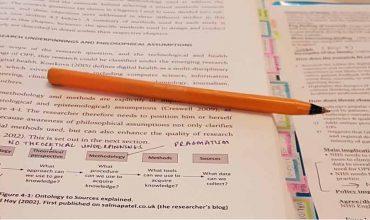The components of a research paper are usually the same as a thesis or a dissertation. In other words, as it was said in “chapters of a master’s thesis”, it has five main sections, plus abstract and some other minor parts.
The most important difference between parts of a research paper and a thesis or dissertation is “table of content” which does not include in a research paper. Furthermore, a research paper is significantly shorter than a thesis or dissertation.
Nevertheless, each academic journal has its own format for acceptance that it has been explained in the “guideline” or in “instructions for authors” menu in the journal’s website. For example, many of them do not need a “literature review” section, while it has been explained in this post.
Title/cover page
Write Paper’s title at the center of a line. Turn to the next line and write author/s name, their title/s, and their emails.
Abstract
Start the
Then give a summary of results, and state what readers should expect to read in the discussion part of your paper.
In a new paragraph write the keywords of your study.
Introduction
Begin the
As you see, introduction starts with general information, then narrows it to the research questions.
Literature Review
Although in this part you are going to review the previous related studies on your topic, it should not be stated as separate parts.
Use the studies have been done as evidence of your study’s significance and gaps. Discuss their findings and results, analyze them, combine different ideas and create a new opinion which is the base of your study.
Methods
In this part, the samples, the scales you have used to measure the variables, and the design of the study should be described.
Explain everything you have done in details, including a complete description of samples, name the used methods, materials, and instruments, and how you did the research to collect the data.
Results and discussion
Now it’s time to report the result. Demonstrate the data collected through the materials in the format of tables, graphs, figures, etc.
Discussion/conclusion
After collecting the data and organizing it, you can interpret them in terms of your research questions. That is to say, in this section, the hypotheses will be confirmed or rejected.
Back to the aims of study and state how your audience would benefit of the results.
Furthermore, make some suggestions for interested researchers to study on, in the future.
References/bibliography
Every research is written based on previous researches. You need to cite the source of every part of your writings clearly. Even if you have written a single sentence from another paper, cite it both after the sentence and in the “references” part.
You may use research papers, theses and dissertations, books, audiovisuals, published and unpublished conference proceedings, and podcasts.
There is a rule for citing every type of source in the body and in references part of a paper. The most known one is APA, a book published by the
Appendix
This part is not necessary. A paper may have not any appendix to be included, but if you have one, you can put it in this part.
Questionnaires, and everything you have used to conduct your research as an instrument.
In order to publish your research paper, you need to consider rules of the publication you are going to publish on. However, there are minor differences between different formats offering by publications and journals.




